I was face to face with a 90-year-old man, intense eyes staring back at me through a dazzling bandit stripe of white clay. He was wearing various parts of many leopards: a tail hanging from his waist, a carcanet of dagger-like teeth around his neck and a strip of skin forming the band of a crown pinned with pearls and shells, topped with vivid, quivering feathers.
I’d first seen Mambwete 30 minutes earlier, shuffling like an arthritic ghost, hunched over a cane. Shortly after licking some dark substance from his palm, he’d begun gyrating, leaping and jiggling his befeathered head to the frenzied rhythm of the twin drummers sitting by my feet.
Mambwete poured some powder, the texture of sawdust, into my hand and beckoned me to swallow it; it was acrid and foul.
I looked across the dark room. Through a shroud of smoke, I could see men, whooping and chanting, their faces painted white, so that they looked like apparitions.
The drumming became more febrile. An antelope horn was blown and several men leapt to their feet, spinning wildly, faces lost in reverie, their grass skirts catching fire from the burning torches they clutched, so they became human Catherine wheels. Others writhed on the floor, prostrating themselves in the dirt at the feet of Mambwete, the Nima, the highest shaman in Gabon, now back on his throne.

I was in the deep forested heart of the central west African country, at a Bwiti ceremony, a religion widespread in Gabon, alongside Christianity and Islam. Participants take iboga, a hallucinogen made from the bark of the sacred shrub of the same name. Through it, initiates gain spiritual enlightenment by communing with dead ancestors — represented by the haunting masks on the walls of the temple, or Mbandja, objects of such exquisite beauty that they inspired Picasso and Matisse. More fundamentally, through Bwiti, initiates learn a core truth of animism: that humans and the forest are one.
The renowned physician and trauma specialist Gabor Maté has claimed that iboga can “lift the veil between our conscious and unconscious . . . and lets you feel your emotions without fear” and as such is an effective treatment for addiction and PTSD.
The iboga must have started its work, because the man now dancing in front me seemed to be, well, levitating.
The day before, I had driven from the capital Libreville for nine hours deep into Gabon’s interior, through its thick tropical rainforests, thought to be up to 100mn years old, among the oldest in the world, which cover an astonishing 88 per cent of the country.
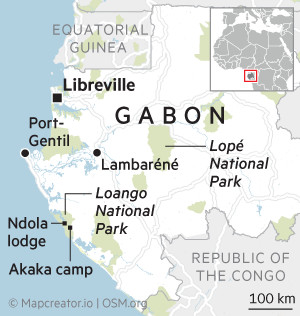
We drove along hideously rutted laterite roads with wheel-swallowing potholes, dodging the murderous logging trucks that coated the roadside trees with red dust, making them look as if they had turned to rust in the humid equatorial air.
Alongside me was Kyle de Nobrega, 33, from South Africa, one of a new generation of guides taking ever more adventurous clients to some of Africa’s more challenging destinations — Chad, South Sudan, the DRC and now, for the first time, Gabon.
“Gabon is the most difficult place I’ve been to, because there is hardly any tourist infrastructure here,” he said, which would help explain why only about 40,000 visitors come each year. A coup d’état last summer, ending 56 years of rule by members of the Bongo family, saw tourism grind to a halt altogether, but the situation has since been calm, with a new transitional government promising elections in August next year.
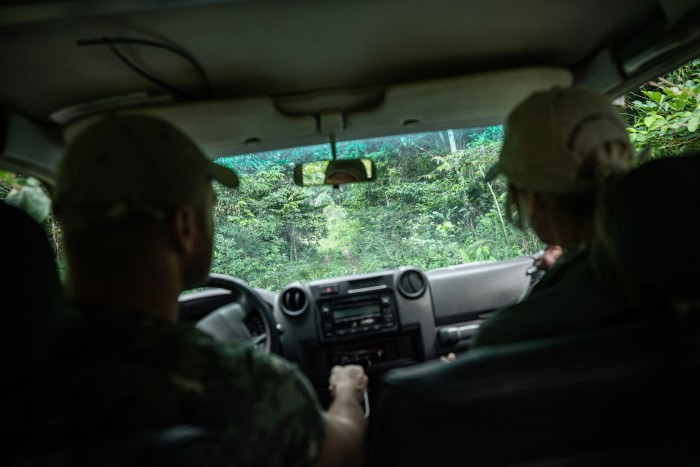
“Once you pass through the difficulties, though,” said Nobrega, “you can appreciate this vast wilderness. Its ancient, natural habitats are largely intact down to good conservation practices, so the wildlife is spectacular, the people lovely. It just takes a little bit of work.”
That spectacular wildlife includes an estimated 95,000 forest elephants — classified as critically endangered — about 65 per cent of the global population — huge groups of mandrills, lowland western gorillas and some 659 bird species. When the country’s authorities recently opted to promote its huge eco-tourism potential under the tagline “Africa’s last Eden”, they had some justification.
We crossed the equator, passing the occasional abandoned wooden village, the jungle devouring it, evidence of the demographic shift that has seen rural Gabonese head for the major coastal cities of Libreville and Port-Gentil, where the majority of the country’s 2.2mn people now live, leaving the interior of a country half the size of its former colonial ruler France seemingly deserted.
We arrived in Lopé National Park, one of 13 created in 2002 under the late president and dedicated conservationist Omar Bongo, which cover 10 per cent of the country and where all hunting is illegal. In the shadow of the Chaillu mountain range, and next to the broad, foaming Ogooué, Gabon’s main river, we met wildlife ecologist David Lehmann and his team.
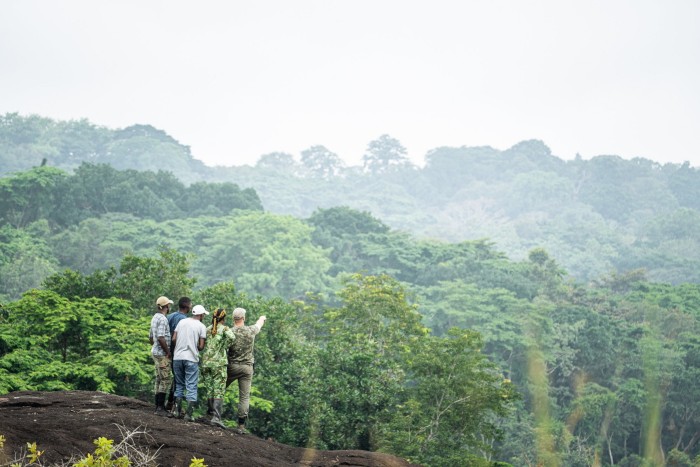
Lehmann, 38, originally from France, has lived in Gabon since 2015 when he turned up with his newly minted PhD to run the research station in the park. “I was raised on Indiana Jones,” he said, as he drove us in his battered Land Cruiser. “Now I am living it.”
We stopped on a high granite outcrop, where David’s team held up a large antennae. They were trying to locate the two collared females in a troop of nearly 1,000 mandrills, believed to be the largest primate group in the world and the subject of David’s research.
Beneath us, stretching to the horizon in every direction, was Lopé’s savannah-forest mosaic — miles and miles of “broccoli” forest, abruptly abutted by patches of open savannah, the lack of liminal habitat making it globally unique, and looking exactly as it would have been for millions of years.
Cackling Congo grey parrots flew overhead. Kyle bent down and picked up several jasper arrow heads, probably dating from before the last Ice Age, just lying there in the dirt as if they had been lost in the hunt that very morning.
Soon we were padding through the tenebrous jungle, our footprints joining a leopard’s in the mud, through columns of 50 metre-tall okoumé trees, corkscrewed by liana vines the thickness of ships’ hawsers, and giant ceibas with huge fins forming the base of their trunks so they looked like rockets a child would draw.
David picked up a leaf dripping with the fresh secretions of a bull forest elephant in musth. “Very dangerous,” said David. “They walk soundlessly, like a ballerina. We might have to run.”
We heard a faint static hiss, which built up until it became like a crashing waterfall, the entire forest vibrating.
“That,” said David, “is what 1,000 mandrills flying through the canopy sounds like.”
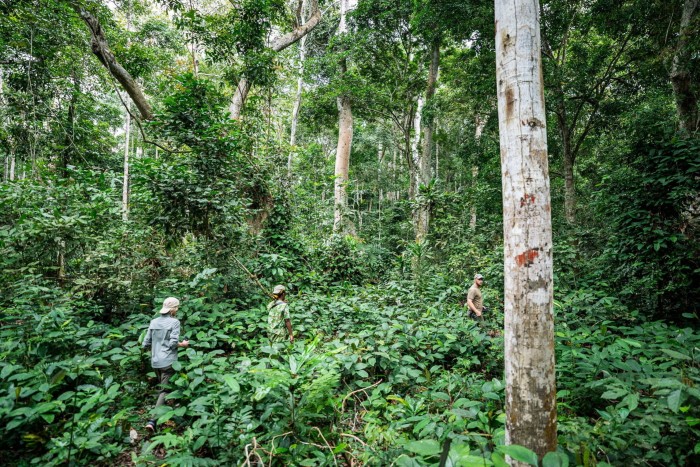

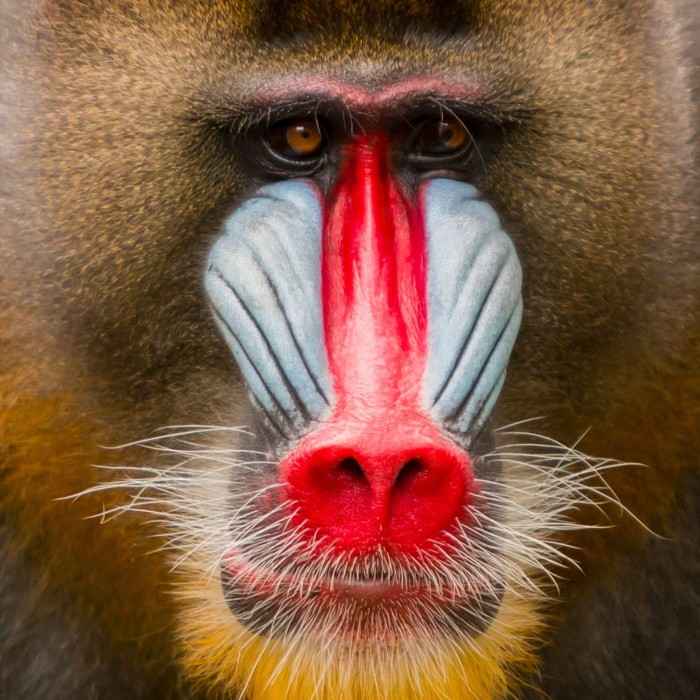
The troop is what’s called “tolerant”, which means that they will allow groups — limited to four guests at a time, twice a day — to come within 70 or 80 metres of them, but no closer. The static stopped. We stood stock still, binoculars trained on the dense green veil, beyond which came guttural barks and grunts.
“There!” David whispered. I followed his finger until, staring back at me through a gap in the foliage, was a huge male mandrill, his lips and nose the most extraordinary vermilion, flanked by thick ridges of cerulean blue, his chin sporting a goatee that looked woven from golden thread; like God had spent at least some of day six on iboga.
“There!” David whispered again, and this time it was a female, her face the colour of burnished ebony, a tiny infant clutching to her chest. More faces followed, like a giant game of peekaboo. Then they were off, the big males lighting the way with their luminescent purple and pink bottoms, which act as beacons for the group in the forest’s gloom, and then all was silent once more.
“Mandrills make you work for it,” said David. “Like Gabon, really.”
That night came the Bwiti ceremony. David was there — in the eight years he had lived in the forest, he had become initiated, a process which takes at least five years of study, ritual and plenty of iboga. “Sometimes it can feel like 10 years’ worth of therapy in one night,” he said, which convinced me (a man for whom a couple of aspirin would usually constitute a drug bacchanal) to give it a go.
The next morning, after a sleepless night of wild but not unpleasant iboga-induced visions (hello long-dead Auntie Pat!), we were back on the spine-crushing road, crossing rusting, rickety metal bridges and passing the odd roadside stall, bushmeat for sale — pangolins, porcupines, monkeys — hanging lifeless from a wire. Kyle told me how the short, dry season, running from late May to mid-September is really the only tourist window in Gabon, outside which many of the roads are impassable.
After a night at Lambaréné, we switched from road to river, speeding back towards the coast along the Ogooué for six hours and 160 miles in a motorised pirogue. We passed the odd fisherman’s shack and the occasional church, whose spire punctured the jungle canopy, but otherwise there were few signs of human life; you felt you had the whole country to yourself.
The bankside foliage started to change, the palms giving way to mangroves, where red-capped mangabeys used the root systems like climbing frames. Shortly afterwards, we burst out of the tight confines of the river into the vast, inky Iguela Lagoon, whose brackish waters, Kyle explained, held an extraordinary mixture of mammals and marine life — bull sharks, elephants, hippos, crocodiles, manatees — and where flocks of African skimmers swooped and darted about in front of our boat.
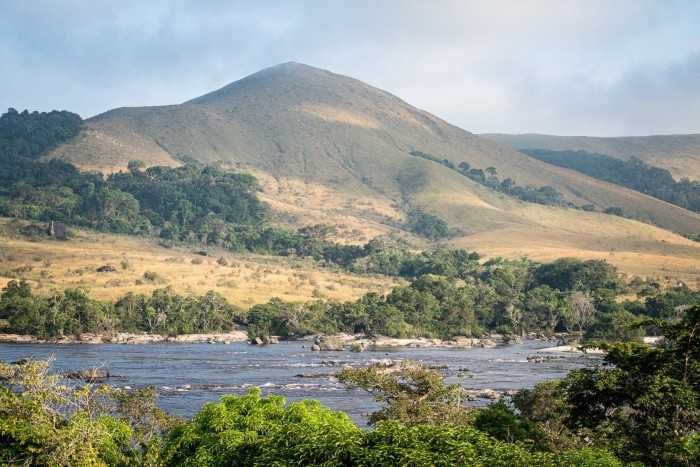
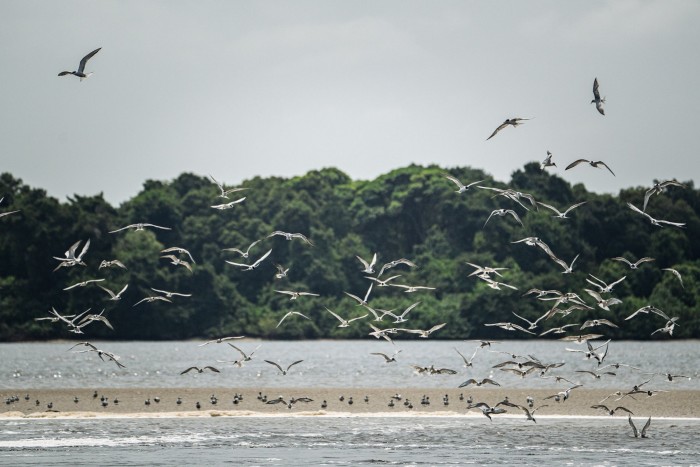
We moored at the jetty at Ndola Lodge, in Loango National Park, one of the few luxury tourist offerings in Gabon, where we ate a superb dinner of meaty, succulent capitaine (Nile perch) steaks on the terrace overlooking the lagoon. We slept in sumptuous, tented rooms, listening to the sound of the Atlantic breakers beyond.
The next day we were back in the dense rainforest, accompanying researchers and guides from Germany’s Max Planck Institute, who have been following a family of lowland western gorillas — also critically endangered — since 2005. Just as with the Lopé mandrills, joining researchers is the only way for visitors to see the primates, with a chunk of our fee going directly to the project.
After two hours of walking in the heat, the guides found the gorillas. Alas, they were in the middle of their favourite habitat, a swamp, where you can sink up to your neck into the Guinness-black mud, and where pythons and biting ants lurk, as well as leeches, one of which a researcher was extracting from her ankle. Gabon really does makes you work for her treasures.
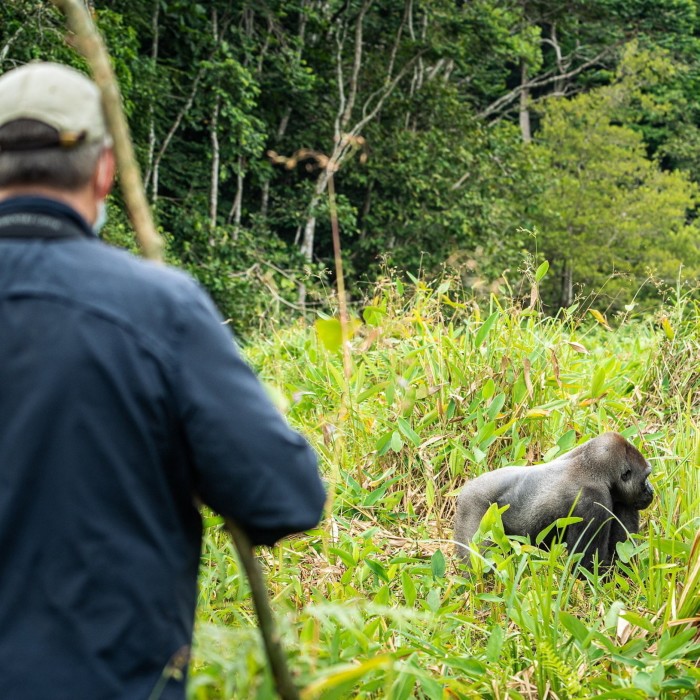
After 20 minutes of squelching and tightrope-walking on the thin logs laid by the trackers across the jellylike floating bed of sedges, ferns and papyrus, trying to avoid grabbing the raphia palms with the razor-sharp edges, we came to a clearing bathed in a celestial glow as if stage-lit.
There, sitting 20 yards from us, was the eight-strong gorilla family, feeding: the 150kg silverback regarded us with studied indifference through ancient, mahogany eyes; two of his juvenile sons wrestled; a tiny baby hopped on and off its mother’s back, checking us out. For an hour we stood there, up to our knees in the swamp, enthralled by as thrilling an animal encounter as I had ever had.
The silverback called time, first by “mock” charging us and then leading his family to the edge of the swamp, where one by one they turned to us in valediction, like hirsute Von Trapps, before disappearing into the forest.
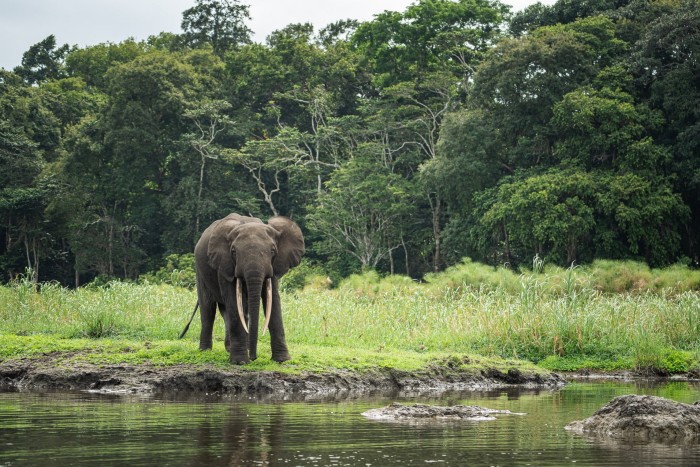
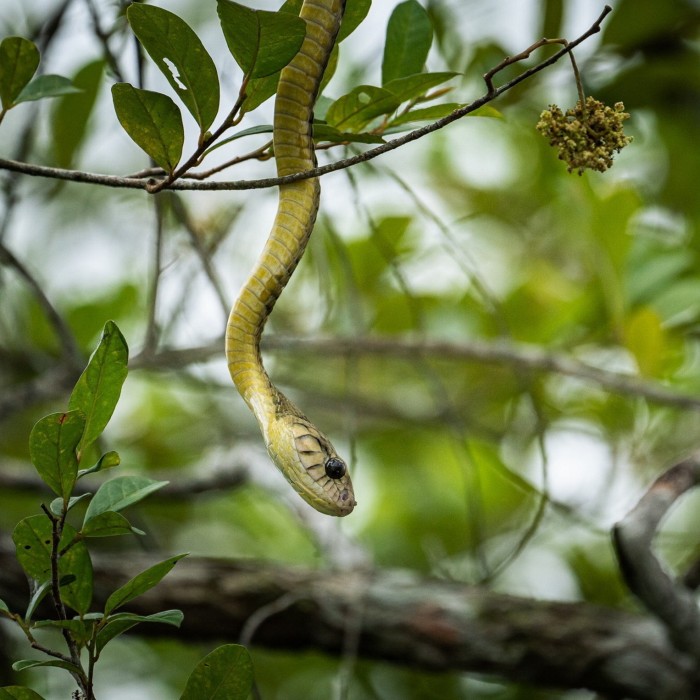
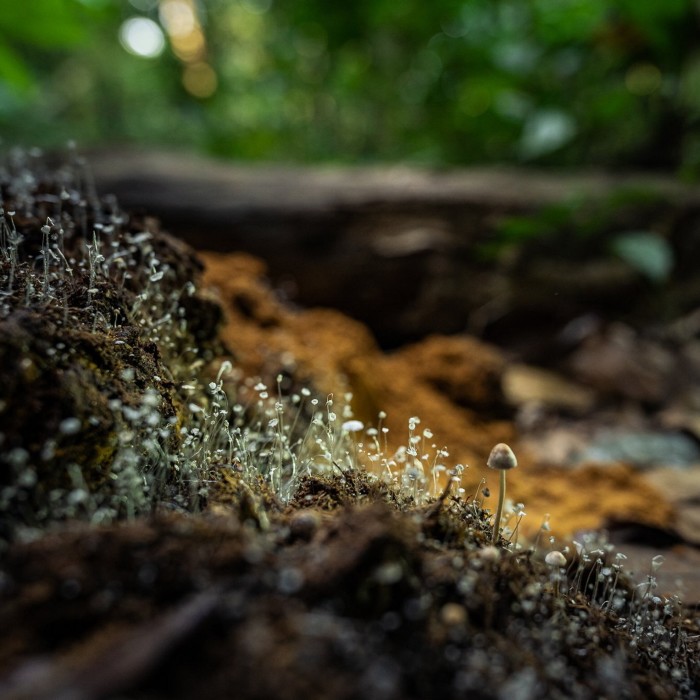
We headed up another of Gabon’s rivers, this one much narrower, the boat slaloming around its tight bends, the jungle so dense that it felt impossible the boat would find a way through.
Brilliant malachite kingfishers darted across the bow, like blue tracer bullets, while goliath herons lumbered into the air. We idled to look at cobras and pythons warming themselves, coiled around the branches of trees, and at slender-snouted crocodiles hauled out on logs.
“There!” Kyle said, and standing by the water was a forest elephant, distinguishable from its larger savannah cousins by its arrow-straight tusks. We killed the engine and drifted towards it, coming within a few feet, the bull continuing to drink, its pale, hazel eyes regarding us with the curiosity and trust of an animal that has not yet learned to fear man. The remoteness of Loango, with its impenetrable swamps and ban on anybody living there, has made the poaching of elephants mercifully rare.
We came to Akaka Camp, a satellite of Ndola Lodge, its five lovely tented rooms and restaurant nestled on the edge of a forest at least 40 miles from the nearest human habitation.
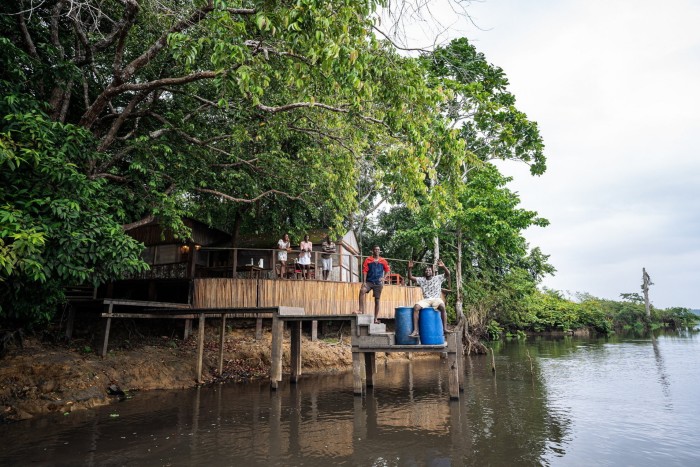
Before dinner, in the fading light, we took the boat out once more. Hippos grunted testily, elephants swam across the river, trunks held aloft like snorkels, while forest buffalo, their ears like feathered purses, squelched in the riverside mud. We had been warned about the infernal tsetse flies but had so far been spared.
Kyle talked a little about his clients, how they were increasingly looking to be exposed to vulnerability and how Gabon, “where you can’t use your credit card as a sword, strips you down to your truest self”.
It was almost dark. A giant black hawk bat swooped low over the boat, hadeda ibis filled the air with their roosting squawks; a hornbill flew through, its wings sounding like a pulsing heartbeat. Somewhere beyond the dark veil came growls and barks and deep, sonorous grunts.
Kyle shone a light towards the bank, picking up the glowing red eyes of dozens of crocodiles watching us drift past.
“The happiest man,” wrote the American essayist Ralph Waldo Emerson, “is he who learns from nature the lesson of worship.” And connection, I thought, remembering the Bwiti, that most sacred of rituals in this most sacred of places.
Details
Mike Carter was a guest of Journeys by Design (journeysbydesign.com) which specialises in off-the-beaten track expeditions in Africa. It offers privately guided trips in Gabon like the one described from $2,000 per person per night. Ethiopian Airlines (ethiopianairlines.com) flies from London Heathrow, Gatwick and Manchester to Libreville via Addis Ababa from £973. See also discovergabon.com
Find out about our latest stories first — follow FTWeekend on Instagram and X, and subscribe to our podcast Life and Art wherever you listen

